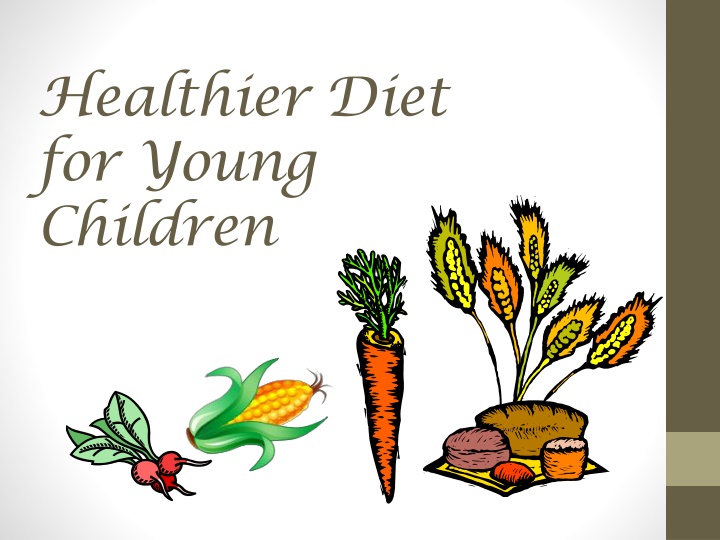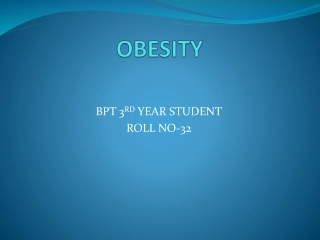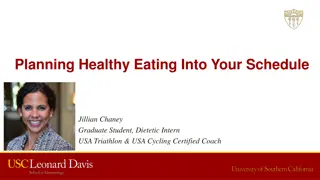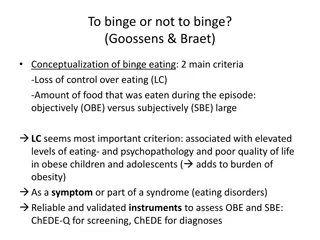Promoting Healthy Eating Habits for Children: Tackling Obesity Through Nutrition
Childhood obesity rates have risen significantly since 1980, with factors like increased availability of snack foods and sedentary lifestyles contributing to the issue. To counter this trend, parents can adopt strategies like involving children in food preparation, making healthy substitutions, setting meal times, and offering nutritious snack and meal choices. Encouraging physical activity and cultivating an interest in food through activities like gardening can also help. Substituting common foods with healthier options and being mindful of portion sizes are key for a balanced diet that promotes children's well-being.
Download Presentation

Please find below an Image/Link to download the presentation.
The content on the website is provided AS IS for your information and personal use only. It may not be sold, licensed, or shared on other websites without obtaining consent from the author.If you encounter any issues during the download, it is possible that the publisher has removed the file from their server.
You are allowed to download the files provided on this website for personal or commercial use, subject to the condition that they are used lawfully. All files are the property of their respective owners.
The content on the website is provided AS IS for your information and personal use only. It may not be sold, licensed, or shared on other websites without obtaining consent from the author.
E N D
Presentation Transcript
Healthier Diet for Young Children
Overweight and Obesity in Children Since 1980 the rates of obesity have doubled for children & tripled for teenagers. More than 15% of all children 6 to 9 years of age are overweight.
Reasons for Increased Obesity Rates Increased availability of snack foods Increased sitting time TV Videogames Phone Larger portions Eating out more Lack of physical activity
How to change eating behavior Involve children in food preparation Making healthy substitutions Finding the right portion sizes Offering healthy snack choices Offering healthy meal choices Increasing activity for the child and the family
Getting Kids Interested in Food and Meals Involve you child in the kitchen, In meal planning, and grocery shopping. Grow a garden and allow your child to plant the seeds and attend to the plants as they grow.
Set meal times To cut down on constant snacking grazing , eat meals around the kitchen or dining room table at set times. Give appropriate low calorie snacks between meals.
Substitutions for Commonly Used Foods Instead of Use Butter, Margarine, or Cream Cheese Light Butter, Light Margarine, or Light Cream Cheese Mayonnaise Low-fat or Fat Free Mayonnaise Frying Baking, Saut ing or Grilling Whole Milk Skim or Low-fat Milk Cheese Low-fat and Reduced-fat Cheese Cookies Animal Crackers, Vanilla Wafers, and Graham Crackers Ice Cream Fruit Bars, Low-fat Frozen Yogurt, Fruit Juice Popsicles White Bread Whole-wheat bread Soda, Punch, Fruit Drinks, or Sports Drinks Water and 100% Fruit Juice Sugared Cereal Whole-grain Cereal Candy Bars, Chocolate Dried Fruit, Fruit Cocktail, or Apple Sauces
Meal Comparison Typical daily meals Omelet, sausage, biscuits, and juice. Bologna sandwich on white bread, soft drink and chips. Healthy daily meals Whole grain cereal, skim milk, juice. Turkey sandwich on whole wheat bread, baked chips and juice. Baked chicken, brown rice, steamed broccoli and unsweetened tea with lemon. Fried chicken, coleslaw and French fries. 2187 Calories, 131 grams of fat 1480 Calories, 17.5 grams of fat
Using the Food Guide Pyramid The Pyramid Food Groups and Serving Sizes Food Group Servings Recommended Example of Serving Size Bread, Cereal, Rice, and Pasta Group 6 servings 2 to 3 Tbsp of pasta, rice, macaroni, to slice of bread, 1 to 2 graham crackers Vegetable Group 3 servings 2 to 3 Tbsp of peas, corn, green beans, mashed potatoes, cup of lettuce Fruit Group 2 servings cup blueberries or raspberries, cup of 100% citrus juice (orange), medium orange, 4 to 6 medium strawberries, 1 medium tangerine, cup of watermelon pieces, of medium size apple/banana/peach/pear/ nectarine, 6 to 8 grapes, cup of cut-up fresh/canned/cooked fruit Milk Group 2 servings 1/4 to 1/3 cup of nonfat or low-fat milk, yogurt, pudding made with milk, 1/2 to 1/3 ounce of cheese Meat Group 2 servings to ounce of meat, chicken, or fish
Snacking Young children need more frequent meals than adults, and they need snacks between meals to support growth and development. When snacks are planned, the child will be more likely to have a healthier snack
Healthy Snack Ideas Instant Pudding made with Non-fat Milk Low-fat Fruited Yogurt Milk String Cheese Frozen Fruit Bars Fresh Fruit Individual Servings of Applesauce or Canned Fruit Dried Pineapple Rings Fruit Juice Raisins (Peeled and Cut up) Cut-up Vegetables with Low-fat Salad Dressing Baby Carrots Graham Crackers Pretzels Dry Cereal Half of a Grilled Cheese Sandwich Vanilla Wafers Soft Pretzels Chicken Taco Animal Crackers
Healthy Breakfasts Cereals Made From Whole Grains All Bran or High Bran Cereals Cheerios Wheat Chex Grape Nuts 100% Bran Bran Buds All-Bran Extra Fiber All-Bran Original All-Bran Bran Flakes Multi-Bran Chex Complete Wheat Bran Flakes Complete Oat Bran Flakes Fiber One Oat Bran Oat Bran Flakes Oat Bran Flakes with Raisins Organic Bran with Raisins Raisin Bran Raisin Bran Flakes Whole Grain Wheat Raisin Bran Raisin Bran Total Healthy Choice Toasted Brown Sugar Squares Just Right with Fruit and Nuts Kashi Raisin Squares Mini-Wheats Frosted Mini-Wheats (Reg. and Bite Size) Muesli Golden Wheat Nutri-Grain Almond-Raisin Nutri-Grain Almond Oatmeal Crisp Apple Cinnamon Oatmeal Crisp Raisin Oatmeal Crisp Oatmeal Squares Puffed Wheat Shredded Wheat Shredded Wheat and Bran Frosted Shredded Wheat (reg. and spoon size) Crispy n Raisins Wheaties
Increasing Activity Limit TV and videogame times. Provide equipment for outdoor activity: bikes, roller blades, balls, Frisbees and kites. Include the whole family when taking bike rides, outings to the park, beach and mountains. Arrange hiking trips. Include the children when taking the dog for a walk.
Comprehensive Approach A healthy lifestyle for children includes an appropriate amount of healthy, unprocessed foods and drinks, adequate amount of physical activity and limiting screen time. Children should engage in at least 60 minutes of physical activity on most, preferably all days of the week. Set consistent patterns of being physically active and consume healthy foods as an example to your child.
Mission: To promote healthier lives through research and education in nutrition and preventive medicine. The Pennington Center has several research areas, including: Clinical Obesity Research Experimental Obesity Functional Foods Health and Performance Enhancement Nutrition and Chronic Diseases Nutrition and the Brain Dementia, Alzheimer s and healthy aging Diet, exercise, weight loss and weight loss maintenance Authors: Beth Kalicki Heli Roy, PhD, RD Division of Education Pennington Biomedical Research Center The research fostered in these areas can have a profound impact on healthy living and on the prevention of common chronic diseases, such as heart disease, cancer, diabetes, hypertension and osteoporosis. The Division of Education provides education and information to the scientific community and the public about research findings, training programs and research areas, and coordinates educational events for the public on various health issues. We invite people of all ages and backgrounds to participate in the exciting research studies being conducted at the PenningtonCenter in Baton Rouge, Louisiana. If you would like to learn more, visit the clinical trials web page at www.pbrc.edu or call (225) 763-3000.























